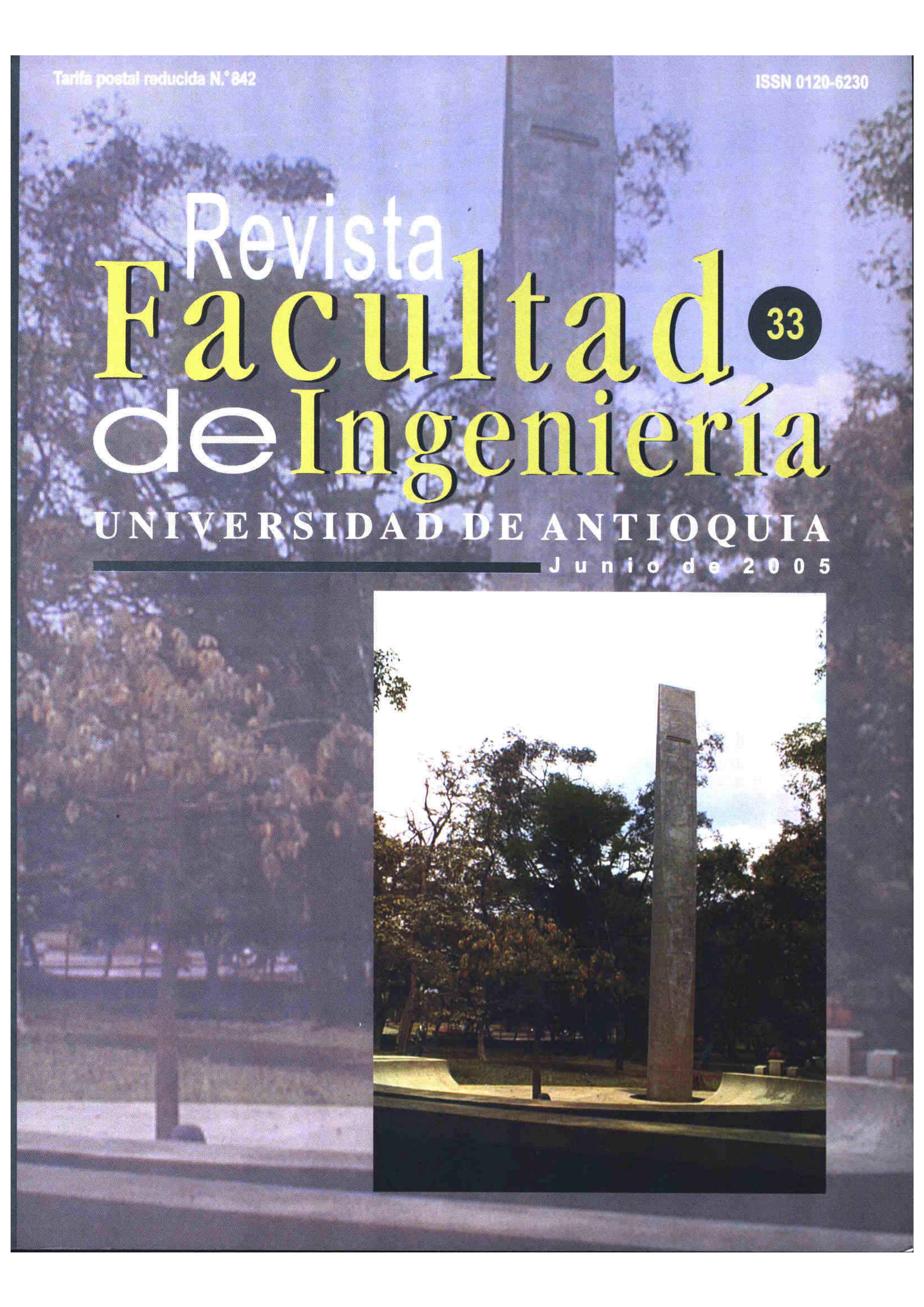Hidroxilación de fenol con catalizadores ZSM-5 modificado con cobre
DOI:
https://doi.org/10.17533/udea.redin.344304Palabras clave:
hidroxilación, fenol, catecol, hidroquinona, Cu-ZSM-5Resumen
Se sintetizaron varios catalizadores Cu-ZSM-5 con diferentes relaciones Si/Al y Si/ Cu. Usando metilamina o hidróxido de sodio como agente mineralizante. Los catalizadores se caracterizaron por DRX, IR, análisis BET, UV-VIS y análisis elemental. El desempeño catalítico de los catalizadores sintetizados se evaluó en la hidroxilación de fenol con H2O2. Se encontró que la relación catecol (CAT)/(hidroquinona (HQ) + p-benzoquinona (PBQ)) aumentó con el contenido de agua, presentó un máximo cuando la relación en peso de agua/fenol fue de 53/1 y se favoreció a altas temperaturas, con el aumento del contenido de aluminio o con la disminución en el contenido de catalizador. El contenido de cobre no fue un factor determinante para la conversión ni para la selectividad en la hidroxilación de fenol. La producción de la p-benzoquinona (PBQ), producto de oxidación de la hidroquinona, fue mínimo cuando se usaron las siguientes condiciones: 80 ºC, fenol: 1 mmol, relación molar fenol/H2O2 de 3/1, catalizador: 20 mg, agua: 5 g, tiempo de reacción: 4 h.
Descargas
Citas
Sheldon, R. et al. “Heterogeneous catalytic oxidations in the manufacture of fine chemicals”. Catalysis Today. Vol. 19. 1999. pp. 215-246. DOI: https://doi.org/10.1016/0920-5861(94)80186-X
Tendulkar, S. B. et al. “Hydroxylation of phenol to dihydroxybenzenes: development of artificial neuralnetwork-based process identification and model predictive control strategies for a pilot plant scale reactor”. Ind. Eng. Chem. Res. Vol. 37. 1999. p. 2081. DOI: https://doi.org/10.1021/ie970509b
Araña, J. et al. “Highly concentrated phenolic wastewater by the photo-fenton reaction, mechanism study by FTIRATR”. Chemosphere. Vol. 44. 2001. pp. 1017-1023. DOI: https://doi.org/10.1016/S0045-6535(00)00359-3
Sun, Jianmin et al. “A novel catalyst of Cu-Bi-V-O complex in phenol hydroxylation with hydrogen peroxide”. Journal of Catalysis. Vol. 193. 2000. pp. 199-206. DOI: https://doi.org/10.1006/jcat.2000.2901
Notari, B. “Synthesis and catalytic properties of titanium containing zeolites”. Innovation in Zeolite Materials Science: Proceedings of an international symposium. Elsevier science publisher B.V. 1987. pp. 413-425. DOI: https://doi.org/10.1016/S0167-2991(09)60618-2
Xiao, Feng-Shou et al. “Synthesis and structure of copper hydroxyphosphate and its high catalytic activity in hydroxylation of phenol by H2O2”. Journal of Catalysis. Vol. 199. 2001. pp. 273-281. DOI: https://doi.org/10.1006/jcat.2001.3166
Valange, S. et al. “Synthesis of copper bearing MFI zeolites and their activity in wet peroxide oxidation of phenol”. Microporous and Mesoporous Materials. Vol. 30. 1999. pp. 177-185. DOI: https://doi.org/10.1016/S1387-1811(99)00031-1
Huu, N. et al. “Characterization and activity of FeZSM-5 catalysts for the total oxidation of phenol in aqueous solutions”. Applied Catalysis B: Environmental. Vol. 34. 2001. pp. 267-275. DOI: https://doi.org/10.1016/S0926-3373(01)00220-X
Lei, G. D. et al. “Identification of Copper (II) and Copper (I) and their interconversion in Cu/ZSM-5 De-NOx catalysts”. Applied Catalysis B: Environmental. Vol 5. 1995. pp. 245-256. DOI: https://doi.org/10.1016/0926-3373(94)00043-3
Gabelica, Z. and S. Valange. “Synthesis of MFI metallosilicate zeolites using metallic amino complexes as mineralizing agents: an overview”. Microporous and Mesoporous Materials. Vol. 30. 1999. pp. 57-66. DOI: https://doi.org/10.1016/S1387-1811(99)00021-9
Fu, Zaihui et al. “Highly effective Cu-HMS catalyst for hydroxylation of phenol”. Catalysis Letters. Vol. 66. 2000. pp. 105-108.
Valange, S. et al. “Direct synthesis of Cu(II) methylamino complexes as mineralizing and reducing agents”. Studies in surface and catalysis. 135. Zeolites and mesoporous materials at the down of 21st century. 2001.
Spoto, G et al. “Cu (I) –ZSM-5 zeolites prepared by reaction of H-ZSM-5 with gaseous CuCl: Spectroscopic characterization and reactivity towards carbon monoxide and nitric oxide”. Applied Catalysis B. Vol. 3. 1994. pp. 151-172. DOI: https://doi.org/10.1016/0926-3373(93)E0032-7
Wilkenhöner, Uwe et al. “Influence of pore and crystal size of crystalline titanosilicates on phenol hydroxylation in different solvents”. Journal of Catalysis. Vol. 203. 2001. pp. 201-212. DOI: https://doi.org/10.1006/jcat.2001.3308
Dubey, A. et al. “Catalytic hydroxylation of phenol over ternary hydrotalcites containing Cu, Ni and Al”. Journal of Catalysis A: Chemical. Vol. 181. 2002. pp. 151-160. DOI: https://doi.org/10.1016/S1381-1169(01)00360-0
Maurya, M. et al. “Oxovanadium (IV) schiff base complexes encapsulated in zeolite-Y as catalyst for the liquid-phase hydroxylation of phenol”. Catalysis Letters. Vol. 86. 2002. pp. 97-105.
Descargas
Publicado
Cómo citar
Número
Sección
Licencia
Los artículos disponibles en la Revista Facultad de Ingeniería, Universidad de Antioquia están bajo la licencia Creative Commons Attribution BY-NC-SA 4.0.
Eres libre de:
Compartir — copiar y redistribuir el material en cualquier medio o formato
Adaptar : remezclar, transformar y construir sobre el material.
Bajo los siguientes términos:
Reconocimiento : debe otorgar el crédito correspondiente , proporcionar un enlace a la licencia e indicar si se realizaron cambios . Puede hacerlo de cualquier manera razonable, pero no de ninguna manera que sugiera que el licenciante lo respalda a usted o su uso.
No comercial : no puede utilizar el material con fines comerciales .
Compartir igual : si remezcla, transforma o construye a partir del material, debe distribuir sus contribuciones bajo la misma licencia que el original.
El material publicado por la revista puede ser distribuido, copiado y exhibido por terceros si se dan los respectivos créditos a la revista, sin ningún costo. No se puede obtener ningún beneficio comercial y las obras derivadas tienen que estar bajo los mismos términos de licencia que el trabajo original.










 Twitter
Twitter